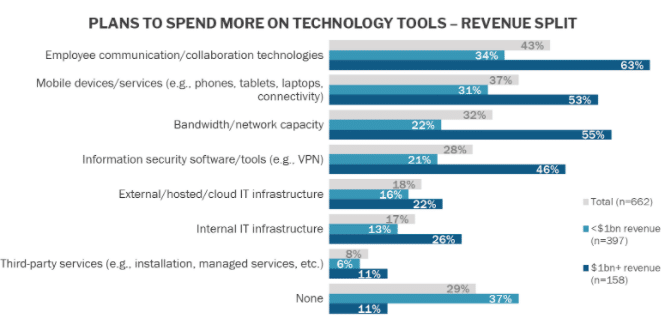The recent global pandemic has undoubtedly triggered an unprecedented shift toward remote work. We’ve seen call centers and contact centers shift from physical locations to virtual ones. As an IT leader, you face unique challenges managing a remote contact center:
- 88% of organizations have asked workers to telecommute while self-isolating at home according to a Gartner poll of global HR executives
- Enterprises using and operating contact centers are rapidly adopting cloud-based services as they pivot their technology strategies because of the COVID-19 pandemic says a new report from Information Services Group (ISG)
- New trend analysis of Aberdeen’s cloud contact center studies shows adoption of cloud technology has risen continuously between 2013 to 2018
This blog post will share some tips and tricks for IT leaders running a virtual contact center. Let’s dive right in.
⭐ Take your contact center to a whole new level ⭐
Next-Gen Cloud Contact Centers for Dummies®, RingCentral Special Edition eBook
Organizations are shifting to virtual contact centers: What IT leaders need to know to prepare
The number of people working remotely has skyrocketed over the last few months as the COVID-19 pandemic forced companies to adapt. Some industries report that 58% of employees currently work remotely.
But, when it comes to call centers and contact centers, approximately 90% of global organizations still use an on-premise solution for their contact centers according to Gartner. 16% of contact center buyers plan to move their contact center systems to the cloud in the future according to Forrester data.
But, for IT leaders, equipping contact center staff for working from home goes beyond just giving call center agents a laptop and a video meetings account. In addition to the challenges of managing remote employees, there are additional challenges to keeping customer data safe.
Maintaining productivity and making sure essential IT services continue uninterrupted during this time can be challenging for IT leaders and staff.
Perhaps you’ve shifted to a hasty solution during COVID-19, and now you’re looking for a more permanent solution.
Or maybe you’re trying to determine whether your virtual contact center should be a strategic shift for your organization or is just good enough to function as a stopgap.
In any case, preparing for success means addressing the tech stack challenges of remote work.
- 72% of IT decision-makers with a tech stack were underprepared to handle a companywide pivot to remote work, according to a survey of 600 IT executives from Xerox.
- 94% of decision-makers admitted that technology glitches have impacted their employees and businesses while working remotely according to a Riverbed report. The most common issues? Poor quality video meetings, frequent disconnects from corporate networks, slow file downloads and long response times when loading apps.
- Landline Internet service providers report network usage has risen as much as 35% and that cell phone network traffic rose as high as 20% during daytime periods according to the Federal Communications Commission
With more than 21 million people in America lacking advanced broadband internet access, one of the major barriers to remote work success has been unreliable home Wi-Fi.
If you’re an IT leader supporting a virtual call center, it’s safe to say you have your hands full.
A whole new world? Challenges with call center management
Today’s environment is a far cry from “business as usual” for IT departments who support virtual teams.
In addition to ensuring that essential IT services are delivered, most IT teams are seeing an unusually high volume of service requests and tickets filed for various work-from-home issues.
Because contact center agents access sensitive customer information like credit card numbers, health data, and financial records, security is also a critical concern.
So is provisioning devices for remote workers. Are your company’s agents using their own personal devices or company-owned devices?
CCW Digital research says “connectivity issues” are the #1 inhibitor to a successful work-from-home program.
In addition to a reliable internet connection, you may need to establish a VPN for employees to access your company network securely.
Other challenges include supplying adequate tools for online collaboration such as meeting and chat platforms and communication, coordinating work streams across different teams, and accelerating digital transformation.
Forrester’s research identified four tools for communication that are the absolute basics organizations need to secure:
- video conferencing
- phones
- file sharing
- and team messaging.
Perhaps the more important question is how will these trends affect operations long-term for your organization?
It seems as if a return to a pre-pandemic office scenario may be a long way off. Many organizations are making plans for phased returns of certain workers with a heavy focus on distributed work whenever feasible.
That’s reflected by Riverbed’s report where business leaders around the world expect an almost 50% increase in employees working from home post-COVID-19.
In anticipation of these developments business leaders are preparing for a new normal:
- According to CIO Dive, 55% of leaders say they’re prioritizing tech spending on remote technology resources. Cloud-based software, remote IT support and collaboration software, are the top three areas for increased IT spending according to surveyed executives
- Up to 72% of business leaders surveyed as part of Riverbed’s recent research reported plans to make additional investments during the next year to make sure they could support a productive remote workforce
- 34% of IT decision-makers expect to spend more on IT resources and assets because of the coronavirus outbreak according to a S&P Global’s 451 Research survey and 40% of software buyers expect software spending to increase because of COVID-19 according to a TrustRadius survey

Image credit: The New Stack
As you can see, it’s important to adjust to changes in the business environment and consider the long-term implications for your IT team as well as the organization as a whole.
[ebook-download title=”Webinar: Transforming a toxic call center environment” link=”https://go.ringcentral.com/transforming-a-toxic-call-center-environment-registration.html” cta-text=”Hear the webinar” src=”https://www.ringcentral.com/us/en/blog/wp-content/uploads/2020/10/WFH-questions.png”]
Benefits of moving the contact center to the cloud
Moving to the cloud is a big decision with strategic implications.
Because replacing physical hardware with a cloud contact center platform empowers your company to shift to remote work immediately and the flexibility to scale on-demand, a move to the cloud can future-proof your organization.
Moving your customer engagement solutions to the cloud allows your organization to scale as business demands, with the tools required to deliver a modern customer experience.
Cloud contact center platforms offer the same functionality or more as on-premises solutions. But, since cloud solutions route inbound and outbound calls through VoIP, they enable any internet-connected device for telephony connectivity. Here are a few more benefits of moving your contact center to the cloud:
Omni-channel customer support — Cloud solutions enable high levels of customer service across multiple channels, including voice, SMS, email and social media.
Financial flexibility — Aberdeen surveyed 302 contact centers across the world and the number one reason 90% of the survey respondents are investing in cloud technology is financial flexibility.
Increase uptime through a more redundant carrier integration — The same research shows 73% of contact centers cite increasing uptime through redundant carrier integration available through cloud contact center providers as the second top reason for shifting to cloud technology.
Provide agents with access to better applications that you can’t afford in-house — 72% of the survey respondents cited the ability to provide agents with access to applications that would have been very costly to access through an on-premises model as a reason for preferring cloud technology.
Enhance security and compliance — Security and compliance have typically been reasons why companies prefer an on-premises deployment model. It seems companies have overcome their concerns in this area as Aberdeen’s trends analysis found 70% of cloud contact center users cite security and compliance as a reason to invest in cloud technology.
Reduce contact center reliance on IT and free IT to focus on more strategic initiatives — Research findings show that companies realize the benefits of freeing IT from managing contact center applications. 62% say reducing dependence on IT helps the IT team focus more on strategic activities needed to provide omnichannel customer interactions.
Here’s how RingCentral can help
Running a virtual call center can present technical challenges for IT but solving those problems that arise is critical to your business’s bottom line.
The top 2,000 corporations in the U.S. field about 50 billion customer cases a year and spend approximately $250 billion every year on customer support. Because contact centers are cost centers, managing costs is critical to your success.
If you’re making the change to remote work, we’re here to help you stay productive.
Unlike inflexible premises-based solutions or stand-alone cloud contact center vendors, RingCentral has a tightly integrated suite of offerings that make it easy for any size organization to deploy and take control of their customer experience on any channel, and to improve agent performance.
Most of the newest innovations are happening in the Cloud today. Platforms, like RingCentral CX solutions, that are Cloud-native, and fully open with the right set of APIs are ideally positioned to harness these latest innovations (AI, Natural Language Platform, etc).
Here are a few more details about our RingCentral CX portfolio:
Easy to manage — Easy-to-use admin and supervisor tools let you set up new users and teams and make changes without needing help from IT.
Collaborate with your team — Quickly access internal experts with team messaging and an integrated corporate directory.
Omnichannel cloud contact center — Keep your agents connected to internal experts with team messaging, video meetings, and a modern business phone—all in one app. Now you can provide support the moment customers need it, even if you’re on the move.
Secure, reliable, open — Stay online with enterprise-grade security and an industry-leading 99.999% uptime SLA.
The world’s #1 business communications platform — We help 400,000+ customers and partners globally provide superior customer engagement with our rich collaborative CX and communications platform.
If you are an IT leader, you’re likely looking for new ways of doing business that allow you to stay productive. At RingCentral, we believe in helping people communicate and collaborate no matter their location or device.
We are now in the middle of the largest ever remote work experiment. Although there are significant challenges associated with remote workforce management, there are also huge benefits for organizations that can provide the technological and practical support necessary for remote workers.
We’ve helped our customers use our communications, collaboration, and contact center solutions to move forward with the cloud transformation of their communications and we can do the same for you.
To learn more about RingCentral’s cloud customer engagement solutions or see our cloud contact center in action, request a demo here.
Originally published Nov 17, 2020, updated Jul 24, 2024





